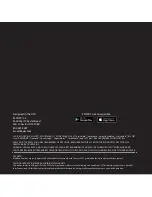
Table 6b:
L5 and T2
–
These mount to the top of the board.
L5
8 turns #28 (5”) on FT37-43, black core
T2
25 turns #28 (15”) on FT37-43, black core. 5 turns #28 (3”) for primary. First wind the 25-turn
secondary. Then wind the 5-turn primary, in the space between the wire ends of the 25-turn secondary.
The 5T primary wires go to 2 center pads of the outline, secondary wires to 2 outside pads.
Winding and mounting of T1:
●
Cut a 24” (2 foot) length of the # 26 wire.
●
Wind 12 turns on the T100-2 core (this is the large red core)
●
Start the winding of the core by passing the starting end of the wire into the hole from the bottom of
core. Wind the rest of the turns in a counter clock wise direction, passing the long end of the wire down
into the core from the top. Winding the core in this fashion will make the ends of the wire more or less
line up with the staggered holes in the board. Try to wind the wire fairly flat to sides of the core.
Space the turns so that they cover about ½ of the core. See photos at bottom of this page.
●
Pull the 6
th
turn on the outside of the core (counting from the left hand starting end) slightly away
from the middle, outside edge of the core.
●
Scrape away the insulation on the wire of this 6
th
turn, near the middle of the core.
●
Cut a 2” length of the # 26 wire and tin one end.
●
Attach this wire to the 6
th
turn on the core. Make a small, half loop on the end of the wire and lightly
crimp to wire on core, then solder.
●
Cut an 18” length of the # 26 wire and wind 6 turns inter-weaved between the first winding and centered
around the tap you just made, so there are 3 turns on each side of the tap. It is easiest the start the
winding of these turns from the center tap of the first winding.
●
Now cut an 8” length of the # 26 wire and wind 1 turns on each side of the tap, for a total of 2 turns.
This winding will also be inter-weaved between the other two windings.
●
Push the windings together so they are close to each other and not spaced around the core.
●
Before mounting T1 to the board, solder in the wires which will connect to the binding posts into the
holes labeled “BP”. (4.5” long) These wire will pass through the center of the core. If the wires are not
installed now, it is difficult to do once T1 is mounted in place.
●
The core is mounted to the bottom of the board, the wires are soldered from the top. Suspend the core
slightly off the bottom of the board so the wires do not touch the ends of the switch mounted above it.
The thick magnet wire is difficult to tin properly, verify connections were made with an ohm meter.
DDS Module:
The final step is to install the DDS module. This gets soldered in place as there isn't enough “head room” for a
socket. The module is installed on the top side of the board and can only go in one way. Once soldered in place,
clip the SIP pins flush to the board. If they are not trimmed back, they may short to the batteries in the
internal battery pack.
Figure 8b:
T1 with HI-Z and
LOW-Z winding
Figure 8c
Figure 8a:
Primary winding of T1
with center tap
Figure 9:
Winding T1






































